华南理工大学:《食品分析》课程PPT教学课件(Food Analysis)Chapter 10 Food Additves Analysis
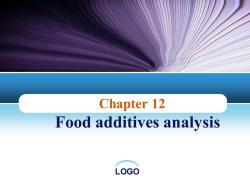
Chapter 12 Food additives analysis LOGO
LOGO Chapter 12 Food additives analysis
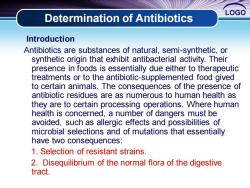
LOGO Determination of Antibiotics Introduction Antibiotics are substances of natural,semi-synthetic,or synthetic origin that exhibit antibacterial activity.Their presence in foods is essentially due either to therapeutic treatments or to the antibiotic-supplemented food gived to certain animals.The consequences of the presence of antibiotic residues are as numerous to human health as they are to certain processing operations.Where human health is concerned,a number of dangers must be avoided,such as allergic effects and possibilities of microbial selections and of mutations that essentially have two consequences: 1.Selection of resistant strains. 2.Disequilibrium of the normal flora of the digestive tract
LOGO Introduction Antibiotics are substances of natural, semi-synthetic, or synthetic origin that exhibit antibacterial activity. Their presence in foods is essentially due either to therapeutic treatments or to the antibiotic-supplemented food gived to certain animals. The consequences of the presence of antibiotic residues are as numerous to human health as they are to certain processing operations. Where human health is concerned, a number of dangers must be avoided, such as allergic effects and possibilities of microbial selections and of mutations that essentially have two consequences: 1. Selection of resistant strains. 2. Disequilibrium of the normal flora of the digestive tract. Determination of Antibiotics
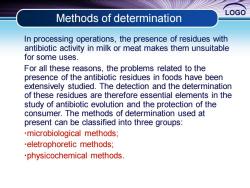
LOGO Methods of determination In processing operations,the presence of residues with antibiotic activity in milk or meat makes them unsuitable for some uses. For all these reasons,the problems related to the presence of the antibiotic residues in foods have been extensively studied.The detection and the determination of these residues are therefore essential elements in the study of antibiotic evolution and the protection of the consumer.The methods of determination used at present can be classified into three groups: .microbiological methods; eletrophoretic methods; physicochemical methods
LOGO Methods of determination In processing operations, the presence of residues with antibiotic activity in milk or meat makes them unsuitable for some uses. For all these reasons, the problems related to the presence of the antibiotic residues in foods have been extensively studied. The detection and the determination of these residues are therefore essential elements in the study of antibiotic evolution and the protection of the consumer. The methods of determination used at present can be classified into three groups: ·microbiological methods; ·eletrophoretic methods; ·physicochemical methods
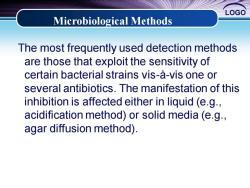
LOGO Microbiological Methods The most frequently used detection methods are those that exploit the sensitivity of certain bacterial strains vis-a-vis one or several antibiotics.The manifestation of this inhibition is affected either in liquid (e.g., acidification method)or solid media(e.g., agar diffusion method)
LOGO The most frequently used detection methods are those that exploit the sensitivity of certain bacterial strains vis-à-vis one or several antibiotics. The manifestation of this inhibition is affected either in liquid (e.g., acidification method) or solid media (e.g., agar diffusion method). Microbiological Methods

LOGO Liquid Medium Methods Principle This technique is widely used for the detection of antibiotics in milk.After pasteurization,the sample is cultured with a strain sensitive to antibiotics (e.g.,Bacillus,Strentococcus,etc.). After incubation,the production of latic acid,which results from the growth of test bacteria in the absence of antibiotic residues,is detected either by a pH indicator or by the coagulation of the milk. The bacterial growth can also be measured by nephtelometry
LOGO Principle This technique is widely used for the detection of antibiotics in milk. After pasteurization, the sample is cultured with a strain sensitive to antibiotics (e.g., Bacillus, Strentococcus, etc.). After incubation, the production of latic acid, which results from the growth of test bacteria in the absence of antibiotic residues, is detected either by a pH indicator or by the coagulation of the milk. The bacterial growth can also be measured by nephtelometry. Liquid Medium Methods
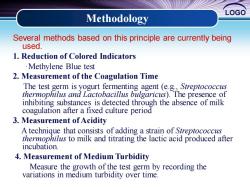
LOGO Methodology Several methods based on this principle are currently being used. 1.Reduction of Colored Indicators Methylene Blue test 2.Measurement of the Coagulation Time The test germ is yogurt fermenting agent (e.g.,Streptococcus thermophilus and Lactobacillus bulgaricus).The presence of inhibiting substances is detected through the absence of milk coagulation after a fixed culture period 3.Measurement of Acidity A technique that consists of adding a strain of Streptococcus thermophilus to milk and titrating the lactic acid produced after incubation. 4.Measurement of Medium Turbidity Measure the growth of the test germ by recording the variations in medium turbidity over time
LOGO Several methods based on this principle are currently being used. 1. Reduction of Colored Indicators ·Methylene Blue test 2. Measurement of the Coagulation Time The test germ is yogurt fermenting agent (e.g., Streptococcus thermophilus and Lactobacillus bulgaricus). The presence of inhibiting substances is detected through the absence of milk coagulation after a fixed culture period 3. Measurement of Acidity A technique that consists of adding a strain of Streptococcus thermophilus to milk and titrating the lactic acid produced after incubation. 4. Measurement of Medium Turbidity Measure the growth of the test germ by recording the variations in medium turbidity over time. Methodology

LOGO Sub-summary By using method studying antibiotics in liquid media,results can be obtained rapidly.They allow the analysis of large series of milk samples and can act as a primary selection method.All positive of questions samples must be subjected to a confirmation test by the agar diffusion method,which is to be described next
LOGO By using method studying antibiotics in liquid media, results can be obtained rapidly. They allow the analysis of large series of milk samples and can act as a primary selection method. All positive of questions samples must be subjected to a confirmation test by the agar diffusion method, which is to be described next. Sub-summary

Agar Diffusion Methods LOGO These techniques have been employed in antibiotic analyses in all food products. Principle When one or more antibiotics in a solution are brought into contact with an agar medium,they diffuse into it.The diffusion is proportional to the logarithm of their concentrations.The growth of a test germ cultured in agar after incubation shows the presence of an inhibiting substance through the appearance of a clear zone in the antibiotic diffusion zone,while everywhere else the growth of the microorganism is visible
LOGO Agar Diffusion Methods These techniques have been employed in antibiotic analyses in all food products. Principle When one or more antibiotics in a solution are brought into contact with an agar medium, they diffuse into it. The diffusion is proportional to the logarithm of their concentrations. The growth of a test germ cultured in agar after incubation shows the presence of an inhibiting substance through the appearance of a clear zone in the antibiotic diffusion zone, while everywhere else the growth of the microorganism is visible

Methodology LOGO Agar Culture Media The composition of the agar medium depends on the strain used and the antibiotic studied.For example,one may use:Healtey's agar; Chabbert medium;Bacto Whey Agar medium.The pH must be adjusted to 6.6 or 7.8,depending on the antibiotic studied. Sample Preparation 1.In its original state(milk); 2.After mixing it aseptically in a small quantity of sterile physiological serum (e.g.,curdled milk,cheese,or antibiotic supplemented food); 3.After solvent extraction(e.g.,muscular tissues).For extraction, three solvents:pure methanol,methanol+pH 8 bicarbonate 1/1 buffer (V/V);or distilled water pH 8 bicarbonate 3/7 buffer (V/V) are recommended
LOGO Agar Culture Media The composition of the agar medium depends on the strain used and the antibiotic studied. For example, one may use: Healtey’s agar; Chabbert medium; Bacto Whey Agar medium. The pH must be adjusted to 6.6 or 7.8, depending on the antibiotic studied. Sample Preparation 1. In its original state (milk); 2. After mixing it aseptically in a small quantity of sterile physiological serum (e.g., curdled milk, cheese, or antibiotic supplemented food); 3. After solvent extraction (e.g., muscular tissues). For extraction, three solvents: pure methanol, methanol + pH 8 bicarbonate 1/1 buffer (V/V); or distilled water + pH 8 bicarbonate 3/7 buffer (V/V) are recommended. Methodology

LOGO Test Microorganisms The following strains are used most often: .Bacillus stearothermophilus var calidolactis strain Bacillus subtilis ATCC 6633, .Sarcina lutea ATCC 9341: .Staphylococcus aureus, Bacillus megaterium ATCC 9855: .Micrococcus luteus and Bacillus cereus. Other sensitive bacteria can also be used; including Micro flavus,Bacillus cereus,Sarcina lutea,and Escherichia coli
LOGO The following strains are used most often: ·Bacillus stearothermophilus var calidolactis strain ·Bacillus subtilis ATCC 6633, ·Sarcina lutea ATCC 9341: ·Staphylococcus aureus, ·Bacillus megaterium ATCC 9855: ·Micrococcus luteus and Bacillus cereus. * Other sensitive bacteria can also be used; including Micro flavus, Bacillus cereus, Sarcina lutea, and Escherichia coli. Test Microorganisms
按次数下载不扣除下载券;
注册用户24小时内重复下载只扣除一次;
顺序:VIP每日次数-->可用次数-->下载券;
- 华南理工大学:《食品分析》课程PPT教学课件(Food Analysis)Chapter 9 Vitamins Analysis.ppt
- 华南理工大学:《食品分析》课程PPT教学课件(Food Analysis)Chapter 8 Amino Acid and Protein Analysis.ppt
- 华南理工大学:《食品分析》课程PPT教学课件(Food Analysis)Chapter 7 Carbohydrates.ppt
- 华南理工大学:《食品分析》课程PPT教学课件(Food Analysis)Chapter 6 Lipids.ppt
- 华南理工大学:《食品分析》课程PPT教学课件(Food Analysis)Chapter 5 Acidity.ppt
- 华南理工大学:《食品分析》课程PPT教学课件(Food Analysis)Chapter 4 Ash and Mineral.ppt
- 华南理工大学:《食品分析》课程PPT教学课件(Food Analysis)Chapter 3 Water Activity.ppt
- 华南理工大学:《食品分析》课程PPT教学课件(Food Analysis)Chapter 2 Physical Methods.ppt
- 华南理工大学:《食品分析》课程PPT教学课件(Food Analysis)Chapter 1 Introduction.ppt
- 华南理工大学:《食品分析》课程教学资源(PPT课件)13 实验方法评价与数据处理下载.ppt
- 华南理工大学:《食品分析》课程教学资源(PPT课件)12 分析质量保证.ppt
- 华南理工大学:《食品分析》课程教学资源(PPT课件)11 食品中有害物质的测定.ppt
- 华南理工大学:《食品分析》课程教学资源(PPT课件)10 食品中限量元素的测定.ppt
- 华南理工大学:《食品分析》课程教学资源(PPT课件)09 食品添加剂的测定.ppt
- 华南理工大学:《食品分析》课程教学资源(PPT课件)08 维生素的测定.ppt
- 华南理工大学:《食品分析》课程教学资源(PPT课件)07 蛋白质及氨基酸分析.ppt
- 华南理工大学:《食品分析》课程教学资源(PPT课件)06 脂类物质的测定.ppt
- 华南理工大学:《食品分析》课程教学资源(PPT课件)05 糖的测定.ppt
- 华南理工大学:《食品分析》课程教学资源(PPT课件)04 酸度的测定.ppt
- 华南理工大学:《食品分析》课程教学资源(PPT课件)03 灰分及矿物质元素.ppt
- 华南理工大学:《食品分析》课程PPT教学课件(Food Analysis)Chapter 11 Trace Elements Analysis.ppt
- 华南理工大学:《食品分析》课程PPT教学课件(Food Analysis)Chapter 12 Reporting Results and Reliability of Analyses.ppt
- 华南理工大学:《食品分析》课程PPT教学课件(食品营养成分分析实验)实验一 食品中还原糖的测定.ppt
- 华南理工大学:《食品分析》课程PPT教学课件(食品营养成分分析实验)实验二 食品中淀粉的测定.ppt
- 华南理工大学:《食品分析》课程PPT教学课件(食品营养成分分析实验)实验三 食品中脂肪的测定.ppt
- 华南理工大学:《食品分析》课程PPT教学课件(食品营养成分分析实验)实验四 油脂中脂肪酸含量测定.ppt
- 华南理工大学:《食品分析》课程PPT教学课件(食品营养成分分析实验)实验五 食品中蛋白质含量测定.ppt
- 华南理工大学:《食品分析》课程PPT教学课件(食品营养成分分析实验)实验六 植物类食品中粗纤维的测定.ppt
- 华南理工大学:《食品分析》课程PPT教学课件(食品营养成分分析实验)实验七 食品中铅、镉、铬的测定.ppt
- 华南理工大学:《食品分析》课程PPT教学课件(食品营养成分分析实验)实验八 食品中维生素C的含量测定.ppt
- 华南理工大学:《食品分析》课程PPT教学课件(食品营养成分分析实验)实验十 食用植物油脂.ppt
- 华南理工大学:《食品分析》课程PPT教学课件(食品安全性检测实验)实验一 食品中亚硫酸盐含量测定.ppt
- 华南理工大学:《食品分析》课程PPT教学课件(食品安全性检测实验)实验三 食品中苏丹红染料的测定.ppt
- 华南理工大学:《食品分析》课程PPT教学课件(食品安全性检测实验)实验四 食品中亚硫酸盐含量测定.ppt
- 华南理工大学:《食品分析》课程PPT教学课件(食品安全性检测实验)实验五 蔬菜中有机磷和氨基甲酸.ppt
- 华南理工大学:《食品分析》课程PPT教学课件(食品安全性检测实验)实验六 食品中有机磷农药残留量.ppt
- 华南理工大学:《食品分析》课程PPT教学课件(食品安全性检测实验)实验七 水产品中孔雀石绿和结晶.ppt
- 华南理工大学:《食品分析》课程PPT教学课件(食品安全性检测实验)实验八 实时荧光PCR检测沙门氏菌.ppt
- 华南理工大学:《食品分析》课程PPT教学课件(食品安全性检测实验)实验九、调味品掺假掺杂的鉴别检验.ppt
- 华南理工大学:《食品分析》课程PPT教学课件(食品安全性检测实验)实验十一 食品中黄曲霉毒素B1的检测.ppt
